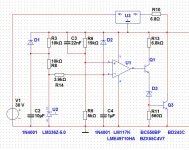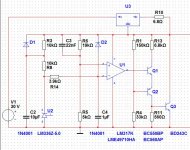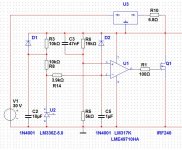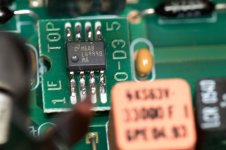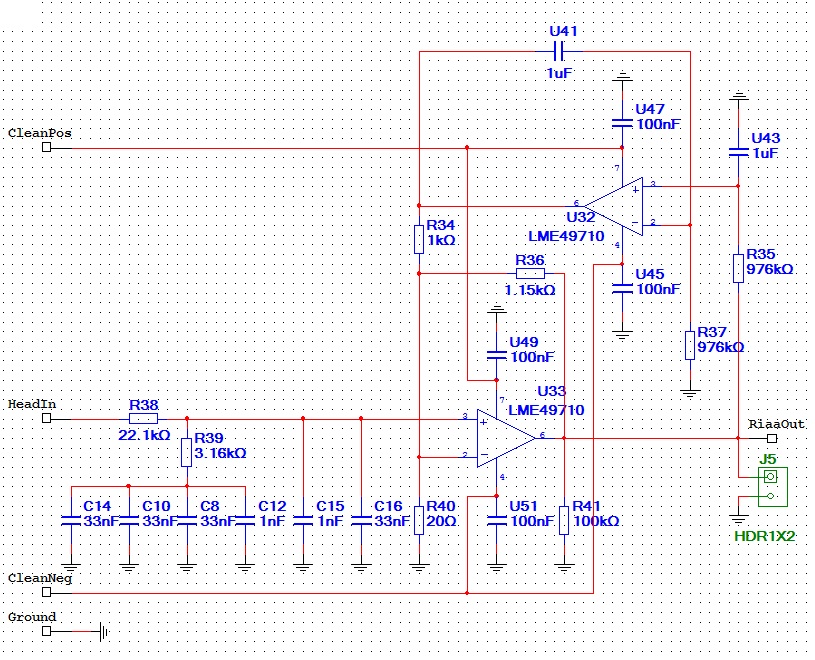TT
Hi Joachim,
I'm still collecting parts to build my super heavy and High-End Turn Table.
I want to use a Granite base and a frosted platter but the bearing is still the problem. I want a bearing that is OK but doesn't cost me an arm and a leg!
The motor will be probably be a DC motor.
Cheers,
Audiofanatic
Hi Joachim,
I'm still collecting parts to build my super heavy and High-End Turn Table.
I want to use a Granite base and a frosted platter but the bearing is still the problem. I want a bearing that is OK but doesn't cost me an arm and a leg!
The motor will be probably be a DC motor.
Cheers,
Audiofanatic
Lift the platter off with magnets and then the bearing is much easier to make.
Scheu in Germany sell parts for bearings that are not expensive and as good as it gets. Put a little preasure on the bearing, maybe one kilo and the bass well be fine too. Totally lifting the bearing comes with a small loss in bass i think.
Scheu in Germany sell parts for bearings that are not expensive and as good as it gets. Put a little preasure on the bearing, maybe one kilo and the bass well be fine too. Totally lifting the bearing comes with a small loss in bass i think.
Frans, you may only lose a few microvolts of signal level - but I believe you will losse a HUGE amount of fine detail, resolution and ambience.
I am a strong supporter of very lightly loading allmost all MCcarts (47k) as it always sounds more alive to me. The only cart I have tried that needed a lowish value of loading R is the IKEDA, which needed something like 100R to sound really natural.
But then, my preamps are tube with 250 to 300V of supply voltage, and around 1 MHz of zero NFB bandwidth, so overload from any ultrasonic resonances just do NOT affect them.
Regards, Allen
Allen, thanks for dropping in, I’m on the middle ground here (I think
I’m not so scared of a bit of noise (but as I said before, the preamp is pretty silent), sound comes first and noise second, it is better to have a good sounding noisy preamp than a crappy sounding 100db s/n one.
In the past I did lots of listening test and found the current setup sounding very nice (it’s an understatement). But, I must admit, it is very difficult to do the sound testing without the possibility of direct comparison. In-between tests the preamp has to be reconfigured, and that takes time. And we are searching for very subtle changes.
Maybe, one day, I will do some new listening test. But this takes some organizing, the record player, SME – Model 20/2, with the SME Series V pick-up arm and the Koetsu cartridge are in Paris (and I am not).
My own listening setup consists of:
, Sure V15VxMR MM cartridge
, SME 9003 II arm with fixed head
, Thorens TD160 B (new plinth build by me and suspended from the concrete sealing)
, Sumo 10 M 200 Watt class a mono blocks
, and finally but not the least Carver Amazing Platinum edition magneto stat panels.
In addition to all this stuff I do have a few very experienced, good eared, friends.
The thing I will/may be doing is use my Uwe Beis 192k 24bit ADC (AD24QS - Audio Analog to Digital Converter 24 Bit / 192 kHz) to make a selection of sound samples and maybe I can compare them that way (but I’m not sure about the viability of that, we have than to consider other influences to the sound).
As always with ‘High-end’ audio, there is no definitive answer, we all do what we see as the best we can, and then we select the one that sounds the best we can hear, and they may be totally different. It’s not a very objective process
Regards,
Frans de Wit.
(Pragmatic high-end audio enthusiast)
Last edited:
I build your input circuit over the weekend with different values. I am using 10 Ohm resistors at the input and 200 Ohm for feedback. I must admit it sounds excellent. No big difference to my post 45 design. See more on my MPP tread. I use the OPA1611.
Yes, the caps in my discete INA have to be selected.
Thanks for confirming that, I knew that it sounds right, but it is good to know (and very pleasing) that we (me and my big eared friends) are not alone
Regards,
Frans de Wit.
As said before, I was going have a look at shunt regulators. After having a look at many designs, I came up with what I think is a good solution. All 3 schema’s added here give about the same simulation results, the most important being, RG less than 10uOhm and Vac (on top of the 24Vdc output) less than 1uV. The design here is created for about 75mA steady state and 125mA peak at 24Vdc out (30Vdc input).
The first, schema uses a zenerdiode as level shifter, this may be a problem due to zener noise, and thus the second schema uses a BC560 for the level shifting. The third design uses an IRF240 as shunt device and therefore does not need a level shifter.
Please note that some parts could be dropped from the design, first of all D2 (but I leave it in there because I like to empty what I fill). For the same reason D1 could be dropped (or left). Also C4 is not absolutely needed (but I like it). If C4 is dropped then you could consider dropping R14 (but I like to have the impedance to both opamp inputs equal). Maybe C3 can be dropped, the simulation shows no definite positive effects for it (but also no negative effects, the current value is about ¼ of the first value that starts having a negative effect (about 100nF)). Then next you could drop C2 (it’s mostly there because I like to have the 'extra' filter). And if you dropped C2 then remove D1 (now it has no purpose at all) and change the 2 10Kohm resistors, R3 and R8, into one 20Kohm, or there about, resistor. All in all you could remove 7 components and still the thing will work. And eh… the IRF240 is a bit of overkill .
.
One more change can be made, the LM317 and associated 6.8 ohm resistor, can be replaced by one 27 ohm resistor. The simulator shows no differences, but using the LM317 is less expensive than using a thick film TO220 mounted resistor (that I could find). It has to absorb about 2 watts and I do not like it very hot, so I think heat sink mounting is preferred.
Maybe it helps someone, I am still undecided about using the shunt designs (if I will use one, then I use number 2 [with the BC560 level shifter]). Absorbing about 2 watts of ‘extra’ energy and still going to the 3rd power supply stage of the preamplifier seems a bit much to me. So, by this I invite everyone to convince me of using a/the shunt regulator .
.
Regards,
Frans de Wit
The first, schema uses a zenerdiode as level shifter, this may be a problem due to zener noise, and thus the second schema uses a BC560 for the level shifting. The third design uses an IRF240 as shunt device and therefore does not need a level shifter.
Please note that some parts could be dropped from the design, first of all D2 (but I leave it in there because I like to empty what I fill). For the same reason D1 could be dropped (or left). Also C4 is not absolutely needed (but I like it). If C4 is dropped then you could consider dropping R14 (but I like to have the impedance to both opamp inputs equal). Maybe C3 can be dropped, the simulation shows no definite positive effects for it (but also no negative effects, the current value is about ¼ of the first value that starts having a negative effect (about 100nF)). Then next you could drop C2 (it’s mostly there because I like to have the 'extra' filter). And if you dropped C2 then remove D1 (now it has no purpose at all) and change the 2 10Kohm resistors, R3 and R8, into one 20Kohm, or there about, resistor. All in all you could remove 7 components and still the thing will work. And eh… the IRF240 is a bit of overkill
One more change can be made, the LM317 and associated 6.8 ohm resistor, can be replaced by one 27 ohm resistor. The simulator shows no differences, but using the LM317 is less expensive than using a thick film TO220 mounted resistor (that I could find). It has to absorb about 2 watts and I do not like it very hot, so I think heat sink mounting is preferred.
Maybe it helps someone, I am still undecided about using the shunt designs (if I will use one, then I use number 2 [with the BC560 level shifter]). Absorbing about 2 watts of ‘extra’ energy and still going to the 3rd power supply stage of the preamplifier seems a bit much to me. So, by this I invite everyone to convince me of using a/the shunt regulator
Regards,
Frans de Wit
Attachments
Last edited:
Frans,
There is only one thing that can convince you to use a shunt reg, and that's your ears - when you listen to a pre using them in comparison with series regs!
But I don't understand how you are using the LM317 in your circuits - for a shunt treg to really work and sound as they can, they MUST be fed via Constant Current Source (CCS), and while a 317 can be configured as a (poor) CCS, I see you wire it as a series voltage reg.
Regards, Allen
There is only one thing that can convince you to use a shunt reg, and that's your ears - when you listen to a pre using them in comparison with series regs!
But I don't understand how you are using the LM317 in your circuits - for a shunt treg to really work and sound as they can, they MUST be fed via Constant Current Source (CCS), and while a 317 can be configured as a (poor) CCS, I see you wire it as a series voltage reg.
Regards, Allen
Frans,
There is only one thing that can convince you to use a shunt reg, and that's your ears - when you listen to a pre using them in comparison with series regs!
But I don't understand how you are using the LM317 in your circuits - for a shunt treg to really work and sound as they can, they MUST be fed via Constant Current Source (CCS), and while a 317 can be configured as a (poor) CCS, I see you wire it as a series voltage reg.
Regards, Allen
Hi Allen,
The LM317 is wired as an 185mA current source, see that the output is connected to the ground pin by a 6.8ohm resistor, and that gives 1.25V/6.8ohm = 183mA.
I will do the experiment, and build the shunt regulators, and then listen. Maybe it will surprise me (and next time when you are visiting Henk I will invite you for a listening session)
Regards,
Frans de Wit.
After building lots of prototypes, first unbalanced and later with balanced inputs, I settled at the configuration show in this post. The posted configuration was considered the best sounding one that I have build and presented to my listening panel (actually 4 people, all used to listen to life music and owning high end audio systems).
I’m sure that posting these schematics is not going to make me famous, and I am aware of the fact that critiques here may make me look a bit silly. But I need to know, what do you diy people here, whose messages I am reading for years on end, think about the thing I concocted .
Let me know what you think of it…
Regards,
Frans de Wit
The first RIAA pre-amp upgrade is in place, the head-amps LME49710's are replaced with LME49990's, thanks to Joachim suggesting those. The total noise performance is way better (it is way more silent). To me it sounds about the same (1st impression
Regards,
Frans de Wit
Attachments
OK on the 317 being used a CCS. I get confused by these simulation type of schematics.
Be happy to hear your stuff but no idea when I again will go to Holland.
Regards, Allen
Allen, whenever you come to Holland I would be more then happy to see you, until then…
Regards,
Frans de Wit
Last edited:
The Ultiboard and Multisim files are in the attached zip archive, if you are interested I do have a set of spare boards.
Regards,
Frans.
This is not working, can anyone tell me how to attach a zip-file.
Regards,
Frans.
Hi Frans
What I wanted to know is the source
Who made the pcb´s for you ?
I am sorry to say, I can't find the info. Most probably is was Quality Sunstone PCB Printed Circuit Boards | Sunstone.com.
Regards,
Frans.
- Status
- This old topic is closed. If you want to reopen this topic, contact a moderator using the "Report Post" button.
- Home
- Source & Line
- Analogue Source
- Balanced input all DC coupled RIAA preamp
